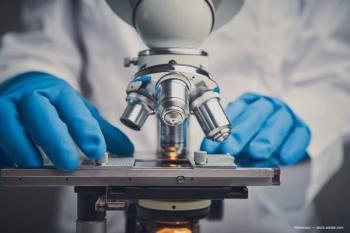
Multi-pressure dial: A new approach to lowering IOP and treating glaucoma
A new therapy provides noninvasive nighttime IOP control by programming the desired pressure into the device, explained John Berdahl, MD, during the New Horizons Forum.
This article was reviewed by John P. Berdahl, MD
A new safe, efficacious nighttime therapy is on the horizon to help prevent IOP spikes. The therapy (Mercury Multi-Pressure Dial (MPD), Equinox Ophthalmic, Inc.) uses a pair of goggles attached to a pump that is worn at night to lower the pressure.
“This device is based on physics,” said John P. Berdahl, MD, who conceptualized the product. “It is a powerful way to measure IOP in a predictable and programmable way.”
The MPD is a new class of treatment that is noninvasive, easy to use, and designed to be worn comfortably at night, which is a vulnerable time for patients with glaucoma.
Dr. Berdahl explained that data from a pivotal study indicated the IOP can be lowered effectively using the MPD by programming the desired pressure into the device.
Dr. Berdahl, the founder and chief medical officer of Equinox Ophthalmic Inc., pointed out that from a business standpoint, the device has revenue potential because it creates a recurring revenue pathway through the durable medical equipment process.
“In this new category, we are targeting where the real unmet needs in glaucoma remain, that is, normal tension glaucoma and severe glaucoma,” he said. “As in other specialties, care in the home, which allows doctors to provide better care outside the office or hospital setting, is becoming more and more important.”
Moreover, Dr. Berdahl explained that the MPD addresses 4 current problems associated with glaucoma.
“Lowering IOP is unpredictable,” he said. “Patient compliance with instillation of eye drops is about 50% — with 5% of the original dose reaching the target tissue. Despite continued innovations in the treatment of difficult-to-treat glaucoma, the safety challenges remain."
Patients continue to have substantial complications related to traditional glaucoma surgeries, according to Dr. Berdahl, and patients continue to lose vision — despite access to the best care and technologies.
Dr. Berdahl envisions that the MPD will slip into the treatment algorithm before traditional glaucoma surgery is performed.
Severe primary open-angle glaucoma (POAG) and normal tension glaucoma affect about 40% of patients, for whom topical drops, laser surgery, and minimally invasive methods such as trabeculectomy may not work well.
"There are problems with traditional surgeries in hard-to-treat patients in that the glaucoma is progressive despite low IOPs,” he said. “This is the market that the MPD is targeting, i.e., the patients with an unmet need.”
This unmet need occurs mostly at night when the IOP increases and when drugs and devices do not seem to work as well, according to Dr. Berdahl. Further, a great deal of data suggest that nighttime is the most vulnerable period for optic nerve damage to occur.
"Longer periods of sleep, over 10 hours a night, have been found to increase the risk of glaucoma by 3-fold,” Dr. Berdahl explained.
How it works
The pump that is attached to the goggles has a 5G-enabled antenna that sends data to the cloud and the doctor can determine if the patient is compliant with the treatment; in addition, patients are reminded to be compliant. The physician can collect the data to understand both the optimal pressure to deliver and for how long to optimally control glaucoma.
The study
Dr. Berdahl and colleagues studied 51 patients whose IOPs were 16 mm Hg. The investigators programmed a 25% pressure decrease into the goggles and the IOPs decreased to about 13 mmHg; when a 50% pressure reduction was programmed into the goggles the IOPs decreased to about 11 mmHg, and with a 75% pressure reduction the IOPs decreased to about 10 mm Hg, he reported.
“For the first time without surgery, laser, or drugs, we can lower the IOP,” Dr. Berdahl said. “More importantly, we can dial it in to a desired level and achieve the goals safely.”
Integration into practice
This new therapy is intended to remove the burden from the physician and practice compared with other product launches medical devices, he pointed out .
In an example scenario, a doctor may tell a patient that he wants the IOP lowered by 7 mmHg in the right eye and by 10 mm Hg in the left eye. The doctor then instructs the patient that he or she will be contacted by Equinox and receive the MPD. The physician’s job then is over. The data recorded by the device will be sent back to the practice to indicate both patient compliance and how well the IOP is controlled.
“The burden shifts to Equinox to process the insurance claims, provide patient training on the MPD, and ensuring that the goggles fit well,” Dr. Berdahl said. “Equinox manages the MPD inventory, ships the device to the patient, and manages the co-pay and goggle resupply.”
Dr. Berdahl concluded that the therapy is a powerful, predictable, programmable way to manage IOP.
“We believe it is a safe, efficacious nighttime therapy that prevents IOP spikes and allows real-time patient monitoring,” he said. “The pivotal study was completed and we believe that the durable medical equipment pathway is beneficial primarily because physicians can be connected directly with the patient’s compliance, take the burden off of health care providers, and provide a meaningful recurring revenue pathway.”
--
John P. Berdahl, MD
E:
Dr. Berdahl is the founder and chief medical officer of Equinox Ophthalmic Inc.
Newsletter
Don’t miss out—get Ophthalmology Times updates on the latest clinical advancements and expert interviews, straight to your inbox.



















































.png)


